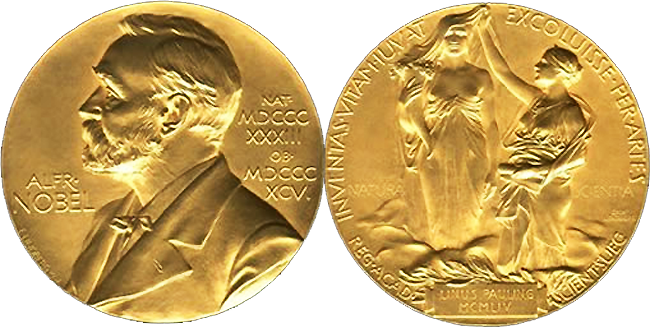The Nobel Prizes, annually awarded in the categories of physics, chemistry, physiology or medicine, literature, peace, and economics, are widely regarded as the supreme commendation in the world. The prizes were instituted by the final will of Alfred Nobel, a Swedish chemist, industrialist, and the inventor of dynamite. In this excerpt of the will, he dictated that his entire remaining estate should be converted into a fund and invested in “safe securities”. The income from the investments should be “distributed annually in the form of prizes to those who during the preceding year have conferred the greatest benefit to mankind”.
At the Nobel Prize Award Ceremonies, on 10 December, the Nobel Laureates receive a Nobel Diploma, a Nobel Medal and a document confirming the Nobel Prize amount. Each Nobel Diploma is a unique work of art, created by foremost Swedish and Norwegian artists and calligraphers. The Nobel Medals are handmade with careful precision in 18k green gold, and plated with 24k gold. Currently, the Nobel Prize amount is set at Swedish kronor (SEK) 8.0 million per full Nobel Prize (roughly 6.1 million RMB).
The widely-know Italian tradition of excellence is proved by its twenty Nobel laureates who, indeed, promoted the progress of science and human knowledge in every field. Indeed, among the outstanding Italian literates who were awarded the Nobel in literature (Dario Fo, Eugenio Montale, Salvatore Quasimodo, Luigi Pirandello, Grazia Deledda), and Ernesto Teodoro Moneta, an international peace activist who was awarded the Nobel in Peace in 1907, the human mankind also owes to Italian scientist many of the discoveries that contributed to shape our modern world.
In Chemistry
Giulio Natta, Nobel 1963, is an Italian engineer and academic.
Natta was awarded the Nobel Prize for Chemistry, with Karl Ziegler, in 1963 for the development of the Ziegler-Natta catalyst, through which polymers (i.e. plastic materials) can be produced. Some of them have been commercialized under the name Moplen (for plastic items) and Meraklon (for textile fiber).
In Physics
Guglielmo Marconi, Nobel 1909, was an Italian inventor, entrepreneur, and electrical engineer.
In 1909 Guglielmo Marconi was the first Italian to be awarded a Noble Prize in Physics, after an intense work lasted about 15 years. The milestone of such process was the first regular transatlantic radio-telegraph service, which finally begun on 17 October 1907. The role played by Marconi Co. wireless in maritime rescues raised public awareness of the value of radio and brought fame to Marconi, particularly the sinkings of the RMS Titanic on 15 April 1912 and the RMS Lusitania on 7 May 1915. He is often credited as the inventor of radio, and he shared the 1909 Nobel Prize in Physics with Karl Ferdinand Braun “in recognition of their contributions to the development of wireless telegraphy”. Guglielmo Marconi also visited Shanghai Jiao Tong University in 1933, and an Antenna Pillar was built on his honor in Xuhui Campus.
Enrico Fermi, Nobel 1938, was an Italian physicist, later a naturalized U.S. citizen.
Enrico Fermi was an Italian physicist, who created the world’s first nuclear reactor, the Chicago Pile-1. He has been called the “architect of the nuclear age” and the “architect of the atomic bomb”. He was one of the few physicists to excel both theoretically and experimentally. Fermi held several patents related to the use of nuclear power, and was awarded the 1938 Nobel Prize in Physics for his work on induced radioactivity by neutron bombardment and the discovery of transuranic elements.
Emilio Segrè, Nobel 1959, was an Italian physicist, later a naturalized U.S. citizen.
Segrè, working with Chamberlain and others, began searching for the antiprotons, a sub-atomic antiparticle of the proton at the prestigious University of Berkeley. He discovered the elements technetium and astatine, and the antiproton, a sub-atomic antiparticle, for which he was awarded the Nobel Prize in Physics in 1959. From 1943 to 1946 he worked at the Los Alamos National Laboratory as a group leader for the Manhattan Project.
Carlo Rubbia, Nobel 1984, is an Italian particle physicist and inventor.
In 1984 Carlo Rubbia and Simon van der Meer were awarded the Nobel Prize for their decisive contributions to the project, which led to the discovery of the field particles W and Z, communicators of weak interaction.
Riccardo Giacconi, Nobel 2002, is an Italian Nobel Prize-winning astrophysicist.
Giacconi was awarded a share of the Nobel Prize in Physics in 2002 “for pioneering contributions to astrophysics, which have led to the discovery of cosmic X-ray sources”. The other shares of the Prize in that year were awarded to Masatoshi Koshiba and Raymond Davis, Jr.
In Physiology Or Medicine
Camillo Golgi, Nobel 1906, was an Italian physician, biologist, pathologist and scientist.
He discovered a method of staining nervous tissue that would stain a limited number of cells at random in their entirety. This enabled him to view the paths of nerve cells in the brain for the first time. He called his discovery the “black reaction” (in Italian, reazione Ital), which later received his name (Golgi’s method or Golgi stain). The black reaction consisted in fixing silver chromate particles to the neuron membrane by reacting silver nitrate with potassium dichromate. This provided an exceedingly clear and well-contrasted picture of neuron against a yellow background.
Daniel Bovet, Nobel 1957, was a Swiss-born Italian pharmacologist.
Bovet won in 1957 the Nobel Prize in Physiology or Medicine for his discovery of drugs that block the actions of specific neurotransmitters. He is best known for his discovery in 1937 of antihistamines, which block the neurotransmitter histamine and are used in allergy medication. His other research included work on chemotherapy, sulfa drugs, the sympathetic nervous system, the pharmacology of curare, and other neuropharmacological interests.
Salvatore Luria, Nobel 1969, was an Italian microbiologist, later a naturalized U.S. citizen.
He won the Nobel Prize in Physiology or Medicine in 1969, with Max Delbrück and Alfred Hershey, for their discoveries on the replication mechanism and the genetic structure of viruses. Salvador Luria showed that bacterial resistance to viruses (phages) is genetically inherited.
Renato Dulbecco, Nobel 1975, was an Italian doctor and biologist.
He won the 1975 Nobel Prize in Physiology or Medicine for his work on oncoviruses, which are viruses that can cause cancer when they infect animal cells. He studied at the University of Turin under Giuseppe Levi, along with fellow students Salvador Luria and Rita Levi-Montalcini, who also moved to the U.S. with him and won Nobel prizes.
Rita Levi-Montalcini, Nobel 1986, was an Italian neurobiologist.
Rita Levi-Montalcini, honored for her work in neurobiology, was awarded the 1986 Nobel Prize in Physiology or Medicine jointly with colleague Stanley Cohen for the discovery of nerve growth factor (NGF). From 2001 until her death, she also served in the Italian Senate as a Senator. At the time of her death, she was the oldest living Nobel laureate.
Mario Renato Capecchi, is an Italian-born American molecular geneticist.
He was awarded the 2007 Nobel Prize in Physiology or Medicine for discovering a method to create mice in which a specific gene is turned off, known as knockout mice. He shared the prize with Martin Evans and Oliver Smithies. He is currently Distinguished Professor of Human Genetics and Biology at the University of Utah, School of Medicine.
In Economics
Franco Modigliani, Nobel 1985, is an Italian economist.
Together with Merton Miller, he was awarded the Noble Prize for the Modigliani–Miller theorem. The basic theorem – firstly published in the 1958 American Economic Review – states that in the absence of taxes, bankruptcy costs, agency costs, and in an efficient market, the value of a firm is unaffected by how that firm is financed. Since the value of the firm depends neither on its dividend policy nor its decision to raise capital by issuing stock or selling debt, the Modigliani–Miller theorem is often called the capital structure irrelevance principle.
For any further information about this topic, write to info@dandreapartners.com






